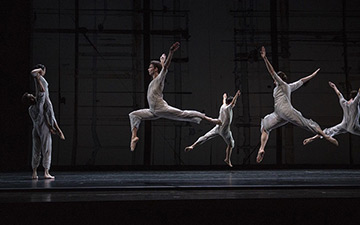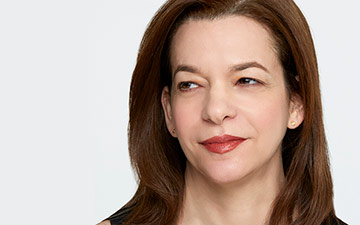
© Christopher Duggan. (Click image for larger version)
Pam Tanowitz Dance
Passagen, Pause Dance, Heaven on One’s Head
New York, Joyce Theater
4 February 2014
pamtanowitzdance.org
www.joyce.org
Letting Go — Pam Tanowitz at the Joyce
It’s nice to change one’s mind about a choreographer once in a while. I’ll come clean: for all their craft and lucidity, I’ve generally found Pam Tanowitz’s dances exceedingly dry, like meticulously-put-together exercises. And that includes The Spectators, her much-lauded piece at New York Live Arts last year. With the exception of a solo for Dylan Crossman and a duet for Crossman and Melissa Toogood, the dance felt arid, like looking at chopped-up phrases of ballet and Cunningham under a microscope.
But more recently, two works by Tanowitz are making me reconsider my opinion. A few weeks ago, New York Theatre Ballet performed her Short Memory, a witty but slightly melancholy piece that riffed on the étude-like structure of ballet class. It was set to Henry Cowell and Lou Harrison piano pieces of shifting moods, and performed on pointe, in brightly-colored toe shoes. Yes, it was still a deconstruction of something else (ballet), but there was a new warmth, and a logic to how it all fit together, with highs and lows. It was a satisfying little work.
This week, Tanowitz has a full evening at the Joyce. (It’s a short evening, about an hour’s worth of dancing, without an intermission.) The program consists of three new works, or rather two plus a little preamble. What’s changed? In the first case, Passagen, set to an unappealing but hyper-virtuosic piece for solo violin by John Zorn, not much. For fifteen minutes the violinist, Pauline Kim Harris, paced around the bare stage, plucking, jabbing, and slicing the strings. Meanwhile, two dancers, the excellent Melissa Toogood and Maggie Cloud, performed tricky combinations of steps with great precision: hopping on one foot while holding the other in a coupé, stomping one heel, and bending their torsos forward; doing simultaneous leg and arm circles, out of sync; walking sideways on their tiptoes while doing the twist. The music and steps coexisted but did no complement or converse in any significant way. Everything looked difficult: the steps, the violin-playing. One admired the performers but felt little else. Tanowitz recently told Ryan Wenzel of the Brooklyn Rail that to make Passagen she put together several female duets from other works. That’s what it felt like: bits and pieces.

© Christopher Duggan. (Click image for larger version)
But then came Heaven on One’s Head. Everything changed. This work felt, not like a commentary on something else, but simply, like a dance, something one could lose oneself in. It began with a short duet, Pause Dance. The Joyce’s crimson velvet curtain was raised halfway, revealing two dancers, Dylan Crossman and Sarah Haarmann, dressed in short costumes made out of a similar crimson velvet material. (The witty costumes were by Reid Bartelme.) The man stood with his back to the audience, while his partner faced forward. She moved quickly; he was almost still. Finally he swiveled and looked into his partner’s eyes with a little hint of a smirk, and it was off to the races.
Seven other dancers joined in. One of them gave a sign, and the Flux Quartet began to play a piece by Conlon Nancarrow. Rhythm and activity filled the stage. Moments of symmetry created passing images of order that then dissolved into multi-directional asymmetry, but never chaos. The dancers were both particles in space – you could watch them one by one without losing interest – and hubs of activity, entering into passing conversations. The whole stage felt alive.
At times, the usually hyper-discreet Tanowitz even gave in to the allure of pure virtuosity. Crossman did a series of leg swings that forced his upper body to whip around from one side to the other (fouettés). Toogood hopped across the stage on one leg while turning and holding the other leg out to the side. There was a whole section of cabrioles, jumps in which the dancer’s feet tap together in the air while flying through space. More than usual for Tanowitz, the dancing reflected the music, not only the general feel but its rhythmic patterns, accents, tempo, and even its folk inflections. Couples lined up, their hands on their hips, as if preparing to do a line dance.

© Christopher Duggan. (Click image for larger version)
Witty motifs returned form one section to the next, particularly one in which a dancer lay with his upper body peeking out of the wings, then hinged into a tilt, and finally was pulled back into the wings by a pair of disembodied hands. In a passage that echoed the opening, the curtain was lowered so that only the dancers’ busy calves and feet were visible.
Perhaps Tanowitz is entering a new, freer phase. Let’s hope so, because for all the intellectual allure of structure and form, a bit of showiness and vitality never hurt. She certainly has an eye for dancers. All of hers are excellent, but Toogood and Crossman, both former members of the Merce Cunningham Dance Company, are something even more rare: the kind of dancers who know, instinctually, how to make each movement count. And now that Tanowitz is finally letting go, we can really see them dance.

















You must be logged in to post a comment.